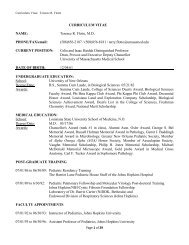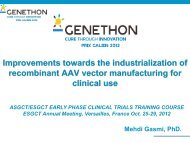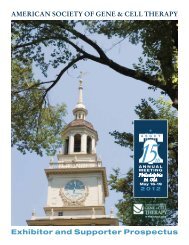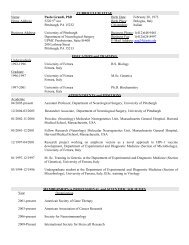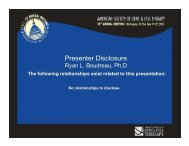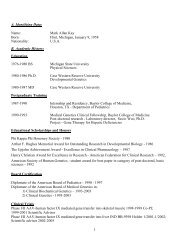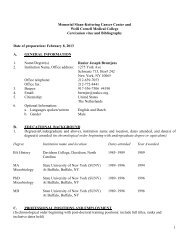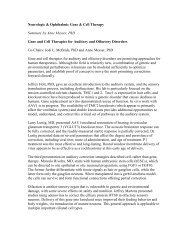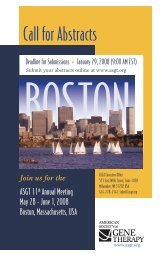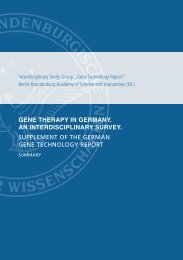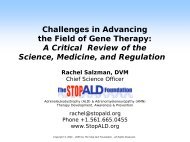13 th AnnUAL MEETing | Washington, DC USA May 19-22, 2010 43Program ScheduleMarkus Grompe, MDHepatobiliary Stem/Progenitor <strong>Cell</strong>sCarolyn Lutzko, PhDDeveloping Stem <strong>Cell</strong> Based Therapies for Lung Disease: Bringing <strong>Gene</strong>s to Lung Stem <strong>Cell</strong>s and Stem <strong>Cell</strong>s to the LungThis presentation will focus on different strategies for developing stem cell based therapies for lung diseases. One strategy that will be discussed is the genetic modification<strong>of</strong> endogenous lung progenitor cells during development. This presentation will also discuss progress on the differentiation <strong>of</strong> lung progenitor cells from pluripotent stemcells in vitro.Mervin C. Yoder, MDAre Endothelial Progenitor <strong>Cell</strong>s Derived from the Endothelial Lining <strong>of</strong> Blood Vessels?Circulating endothelial progenitor cells (EPC) have been reported to play important roles in vascular repair and regeneration and are altered in concentration in patientswith arthritis, diabetes, cancer, and cardiovascular disease. No unique marker exists to identify this cell. Indeed, evidence suggests that numerous cell types participate inneoangiogenesis under the term EPC. We will review recent literature that suggests the local endothelial lining to be a major site <strong>of</strong> vascular repair.Scientific Symposium 21210:30 am - 12:30 pmRoom: Virginia Suite<strong>Cell</strong> and <strong>Gene</strong> <strong>Therapy</strong> Approaches for <strong>Gene</strong>tic Diseases: Progress and ChallengesChairCharles P. Venditti, MD, PhDSpeakersNathalie Cartier-Lacave, MD<strong>Gene</strong> <strong>Therapy</strong> for AdrenoleukodystrophyWe report results <strong>of</strong> the first clinical trial using an HIV vector to correct hematopoietic stem cells (HSC) in adrenoleukodystrophy, a severe degenerative disease <strong>of</strong> thecentral nervous system. Three children received autologous corrected HSC after full myeloablative conditionning. Up to 36 months after treatment, stable expression wasdemonstrated in peripheral blood leukocytes and bone marrow CD34+ cells, with polyclonal integration <strong>of</strong> the lentiviral vector. Neurological outcome was comparable tothat observed after allogeneic transplantation. These results demonstrate that lentiviral vectors are promising tools for gene transfer into hematopoietic stem cells in theabsence <strong>of</strong> selective advantage.Alessandra Biffi, MDHSC <strong>Gene</strong> <strong>Therapy</strong> for Metachromatic and Globoid Leukodystrophies: The Next Trials for Inherited Neurological DisordersWe are implementing a gene therapy approach based on the transplantation <strong>of</strong> gene corrected hematopoietic stem cells (HSC) for the treatment <strong>of</strong> severe forms <strong>of</strong>Lysosomal Storage Disorders (LSD) lacking efficacious and safe alternative therapeutic opportunities. To this goal, we exploit the unique features <strong>of</strong> lentiviral vectors (LV),which are prime candidates for HSC gene transfer. Indeed, by using LV for HSC gene correction, we proved the therapeutic potential and safety <strong>of</strong> HSC gene therapy in themurine model <strong>of</strong> metachromatic leukodystrophy (MLD), a severe dysmyelinating LSD. According to these promising results, HSC gene therapy for MLD has now reachedclinical testing. Similarly, an advanced LV design allowed rendering HSC gene therapy a feasible and efficacious approach to be further developed also for globoid cellleukodystrophy, on which we obtained very promising evidences in the disease model.Ronald D.G. McKay, PhDRobert D. Steiner, MDCNS Transplantation <strong>of</strong> Neural Stem <strong>Cell</strong>s in Neuronal Ceroid Lip<strong>of</strong>uscinoses: Phase I Trial ResultsInfantile and late-infantile neuronal ceroid lip<strong>of</strong>uscinosis (INCL and LINCL) are universally fatal neurodegenerative lysosomal storage disorders caused by palmitoyl proteinthioesterase and tripeptidyl peptidase deficiency, respectively. A Phase I trial <strong>of</strong> human central nervous system stem cells (HuCNS-SC®) was conducted in subjects withINCL and LINCL. This study represents the first US FDA authorized use <strong>of</strong> human neural stem cells for clinical testing. The primary goal <strong>of</strong> the trial was to evaluate thesafety <strong>of</strong> direct CNS delivery <strong>of</strong> HuCNS-SC, the immunosuppression regimen, and the surgical technique. Six children underwent HuCNS-SC transplantation;. the studyresults to be presented will include adverse events as well as the neurological, seizure, EEG, radiological, neuropsychological, functional, and quality-<strong>of</strong>-life measuresassessed at frequent intervals post-transplant, as well as evidence <strong>of</strong> engraftment.Thursday, May 20 th
44<strong>American</strong> <strong>Society</strong> <strong>of</strong> <strong>Gene</strong> & <strong>Cell</strong> <strong>Therapy</strong>Program ScheduleThursday, May 20 thScientific Symposium 21310:30 am - 12:30 pmRoom: Delaware SuiteHow Viruses Cause Disease: Implications for Vector and Vaccine DevelopmentChairRoberto Cattaneo, PhDSpeakersLynn W. Enquist, PhDResponse <strong>of</strong> PNS Neurons to Herpesvirus InfectionMost alpha herpesviruses are pantropic, neuroinvasive pathogens that establish a reactivateable, latent infection in the peripheral nervous system <strong>of</strong> their natural hosts.Various manifestations <strong>of</strong> herpes disease rely on extent and direction <strong>of</strong> the spread <strong>of</strong> infection between the surface epithelia and the nervous system components thatinnervate that surface. One aspect <strong>of</strong> such controlled spread <strong>of</strong> infection is the capacity for synaptically defined, transneuronal spread, a property that makes alphaherpesviruses useful tools for determining the connectivity <strong>of</strong> neural circuits and gene delivery. Spread <strong>of</strong> infection among neurons involves long distance travel <strong>of</strong> virioncomponent in axons. I will discuss our recent work on the response <strong>of</strong> cultured PNS neurons to infection.Jeffrey Bergelson, MD<strong>Cell</strong> Biology <strong>of</strong> Virus EntryViruses need cells, and they have evolved to manipulate cellular processes at many stages <strong>of</strong> their life cycle. In a number <strong>of</strong> cases, virus-induced signals are needed toprepare the cell for virus entry and infection. I will discuss several examples <strong>of</strong> viruses— including adenoviruses and picornaviruses— that use receptor-mediated signalsto initiate the entry process.Bernard Moss, MD, PhDPoxvirus Replication and Pathogenesis: Implications for Vector and Vaccine DevelopmentThe ability <strong>of</strong> vaccinia virus to infect most cells provides an important advantage for their extensive use as an expression vector and as an oncolytic agent. We have shownthat an unprecedented number <strong>of</strong> viral proteins are required for the membrane fusion step, which can occur either at the plasma membrane or in endosomes. These 12proteins are associated in a complex and conserved in all members <strong>of</strong> the poxvirus family.Roberto Cattaneo, PhDThe Force Behind Targeting: How the Receptor-Triggered Membrane Fusion Mechanism <strong>of</strong> Measles Virus WorksMeasles is one <strong>of</strong> the most infectious viruses, and its portable entry system has become the paradigm for targeting oncolysis and therapeutic gene delivery. While thissystem is strictly regulated, the mechanism triggering fusion <strong>of</strong> the viral envelope with the plasma membrane was unknown. We show that re-alignment <strong>of</strong> the subunits <strong>of</strong>the viral attachment protein (H) is the trigger, and that force exerted at an appropriate location on the H-dimer unlocks the trigger at the plasma membrane, just as lowpH or proteases trigger endosomal membrane fusion in other viral entry systems.Scientific Symposium 21410:30 am - 12:30 pmRoom: Maryland Suite<strong>Gene</strong> and <strong>Cell</strong> Therapeutic Approaches for Musculo-Skeletal DiseasesCo-ChairsPaula Clemens, MD & Alan J. Nixon, DVM, MSSpeakersEdward M. Schwarz, PhDRevitalizing Structural AllograftsTo the end <strong>of</strong> a tissue-engineering solution for large segmental defects in bone caused by trauma or tumors, we proposed rAAV-coated allografts, which introduce angiogenic,osteogenic and osteoclastogenic factors into the healing environment to stimulate vascular ingrowth, bone formation and remodeling <strong>of</strong> the necrotic tissue. Here Iwill describe the molecular biology <strong>of</strong> this technology, its methodology and application in mice, and the translational outcome measures that have been developed to proveefficacy in large animals and humans in which torsional biomechanical strength is the primary outcome measure.EXHIBITOR PROSPECTUSfinal program
- Page 1 and 2: FINAL PROGRAMAmerican Society of Ge
- Page 4: 13 th AnnUAL MEETing | Washington,
- Page 7 and 8: 6American Society of Gene & Cell Th
- Page 12 and 13: 13 th AnnUAL MEETing | Washington,
- Page 20 and 21: 13 th AnnUAL MEETing | Washington,
- Page 22 and 23: 13 th AnnUAL MEETing | Washington,
- Page 24 and 25: 13 th AnnUAL MEETing | Washington,
- Page 26 and 27: 13 th AnnUAL MEETing | Washington,
- Page 28 and 29: 13 th AnnUAL MEETing | Washington,
- Page 30 and 31: 13 th AnnUAL MEETing | Washington,
- Page 32 and 33: 13 th AnnUAL MEETing | Washington,
- Page 34 and 35: 13 th AnnUAL MEETing | Washington,
- Page 36 and 37: 13 th AnnUAL MEETing | Washington,
- Page 38 and 39: 13 th AnnUAL MEETing | Washington,
- Page 40 and 41: 13 th AnnUAL MEETing | Washington,
- Page 42 and 43: 13 th AnnUAL MEETing | Washington,
- Page 46 and 47: 13 th AnnUAL MEETing | Washington,
- Page 48 and 49: 13 th AnnUAL MEETing | Washington,
- Page 50 and 51: 13 th AnnUAL MEETing | Washington,
- Page 52 and 53: 13 th AnnUAL MEETing | Washington,
- Page 54 and 55: 13 th AnnUAL MEETing | Washington,
- Page 56 and 57: 13 th AnnUAL MEETing | Washington,
- Page 58 and 59: 13 th AnnUAL MEETing | Washington,
- Page 60 and 61: 13 th AnnUAL MEETing | Washington,
- Page 62 and 63: 13 th AnnUAL MEETing | Washington,
- Page 64 and 65: 13 th AnnUAL MEETing | Washington,
- Page 66 and 67: 13 th AnnUAL MEETing | Washington,
- Page 68 and 69: 13 th AnnUAL MEETing | Washington,
- Page 70 and 71: 13 th AnnUAL MEETing | Washington,
- Page 72 and 73: 13 th AnnUAL MEETing | Washington,
- Page 74 and 75: 13 th AnnUAL MEETing | Washington,
- Page 76 and 77: 13 th AnnUAL MEETing | Washington,
- Page 78 and 79: 13 th AnnUAL MEETing | Washington,
- Page 80 and 81: 13 th AnnUAL MEETing | Washington,
- Page 82 and 83: 13 th AnnUAL MEETing | Washington,
- Page 84 and 85: 13 th AnnUAL MEETing | Washington,
- Page 86 and 87: 13 th AnnUAL MEETing | Washington,
- Page 88 and 89: 13 th AnnUAL MEETing | Washington,
- Page 90 and 91: 13 th AnnUAL MEETing | Washington,
- Page 92 and 93: 13 th AnnUAL MEETing | Washington,
- Page 94 and 95:
13 th AnnUAL MEETing | Washington,
- Page 96 and 97:
13 th AnnUAL MEETing | Washington,
- Page 98 and 99:
13 th AnnUAL MEETing | Washington,
- Page 100 and 101:
13 th AnnUAL MEETing | Washington,
- Page 102 and 103:
13 th AnnUAL MEETing | Washington,
- Page 104 and 105:
13 th AnnUAL MEETing | Washington,
- Page 106 and 107:
13 th AnnUAL MEETing | Washington,
- Page 108 and 109:
13 th AnnUAL MEETing | Washington,
- Page 110 and 111:
13 th AnnUAL MEETing | Washington,
- Page 112 and 113:
13 th AnnUAL MEETing | Washington,
- Page 114 and 115:
13 th AnnUAL MEETing | Washington,
- Page 116 and 117:
13 th AnnUAL MEETing | Washington,
- Page 118 and 119:
13 th AnnUAL MEETing | Washington,
- Page 120 and 121:
13 th AnnUAL MEETing | Washington,
- Page 122 and 123:
13 th AnnUAL MEETing | Washington,
- Page 124 and 125:
13 th AnnUAL MEETing | Washington,
- Page 127 and 128:
126American Society of Gene & Cell
- Page 129 and 130:
128American Society of Gene & Cell
- Page 131 and 132:
130American Society of Gene & Cell
- Page 133 and 134:
132American Society of Gene & Cell
- Page 135 and 136:
134American Society of Gene & Cell
- Page 137 and 138:
136American Society of Gene & Cell
- Page 139 and 140:
138American Society of Gene & Cell
- Page 141 and 142:
140American Society of Gene & Cell
- Page 143 and 144:
142American Society of Gene & Cell
- Page 145 and 146:
144American Society of Gene & Cell
- Page 147 and 148:
146American Society of Gene & Cell
- Page 149 and 150:
148American Society of Gene & Cell
- Page 151 and 152:
150American Society of Gene & Cell
- Page 153 and 154:
152American Society of Gene & Cell
- Page 155 and 156:
154American Society of Gene & Cell
- Page 157 and 158:
156American Society of Gene & Cell
- Page 159 and 160:
158American Society of Gene & Cell
- Page 161 and 162:
160American Society of Gene & Cell
- Page 163 and 164:
162American Society of Gene & Cell
- Page 165 and 166:
164American Society of Gene & Cell
- Page 167 and 168:
166American Society of Gene & Cell
- Page 169 and 170:
168American Society of Gene & Cell
- Page 171 and 172:
170American Society of Gene & Cell
- Page 173 and 174:
172American Society of Gene & Cell
- Page 175 and 176:
174American Society of Gene & Cell
- Page 177 and 178:
176American Society of Gene & Cell
- Page 179 and 180:
178American Society of Gene & Cell
- Page 181 and 182:
180American Society of Gene & Cell
- Page 183 and 184:
182American Society of Gene & Cell
- Page 185 and 186:
184American Society of Gene & Cell
- Page 187 and 188:
186American Society of Gene & Cell



